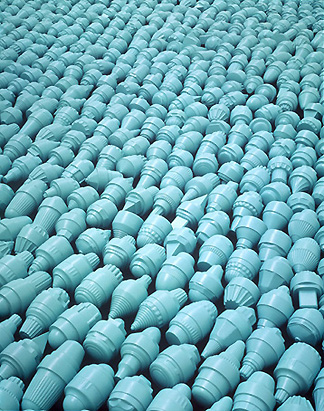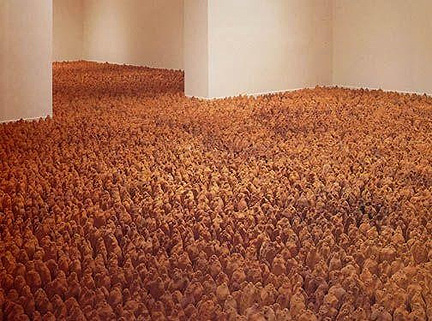Allan McCollum, 1987/88
Over Ten Thousand Individual Works.
Over Ten Thousand Individual Works (1987/88) is a sculpture by American artist Allan McCollum. It consists of over ten thousand hand-sized cast plaster (Hydrocal) shapes, each 2 inches in diameter and varying in length from 2 to 5 inches. The shapes were created from rubber molds the artist made from a few hundred found objects, such as bottle caps, toys, door pulls and other parts of mass-produced items. The parts were pieced together using an arithmetic system in such a way that no two would be alike. The works were hand cast and hand painted by dozens of helpers working for months in different small loft spaces in New York City. The specific width and depth of the table the objects rest upon is changed to suit each location, but the Individual Works are always placed in a dense, orderly array, and occupy approximately 400 square feet.
First shown in New York City at the John Weber Gallery in 1988, Over Ten Thousand Individual Works has been shown in the U.S. at the Whitney Museum of American art in New York, the Los Angeles Museum of Contemporary Art in Los Angeles, and at the Wexner Center for the Arts in Columbus, Ohio; and in many countries throughout Europe: the Stedelijk Van Abbemuseumdhoven in Eindhoven, Holland (1989), Serpentine Gallery in London (1990), the IVAM Centre del Carme, Valencia, Spain (1990), at the Musée d'art moderne Villeneuve d'Ascq, France, and others.
Three versions of the work were produced between 1988 and 1992, making a total of around 35,000 of the objects in all, with no two shapes alike. One Over Ten Thousand Individual Works piece is in the permanent collection of the Louisiana Museum of Modern Art, Humlebaek, Denmark, and another Over Ten Thousand Individual Works are in the permanent collection of the the Kunstmuseum Wolfsburg, in Wolfsburg, Germany.
| |
Anthony Gormley, 1991.
Field
Field (1991) is a sculpture by British artist Anthony Gormley. It consists of 35,000 individual terracotta figures, each about 25cm high, installed on the floor of a room facing the viewer. The figures were sculpted by the Texca family of brick-makers in San Matias, Cholula, Mexico. Thirty-five thousand figures were made by about sixty men, women and children aged from six to over sixty, mostly members of the extended family.
Field has been installed and displayed at various locations.. Ideally the Field is extended through a doorway or round a corner, so that the figures going out of sight leave the impression of an unlimited hoard.
Several other versions of Field have subsequently been created, including Amazonian field (1992) made in Porto Velho, Brazil; Field for the British Isles (1993) made in St Helens near Liverpool in the UK; European field (1993) made in Östra Grevie, Sweden.
In 1994, Gormley won the Turner prize with a collection of his work, including Field for the British Isles, shown at the Tate Gallery.
|

